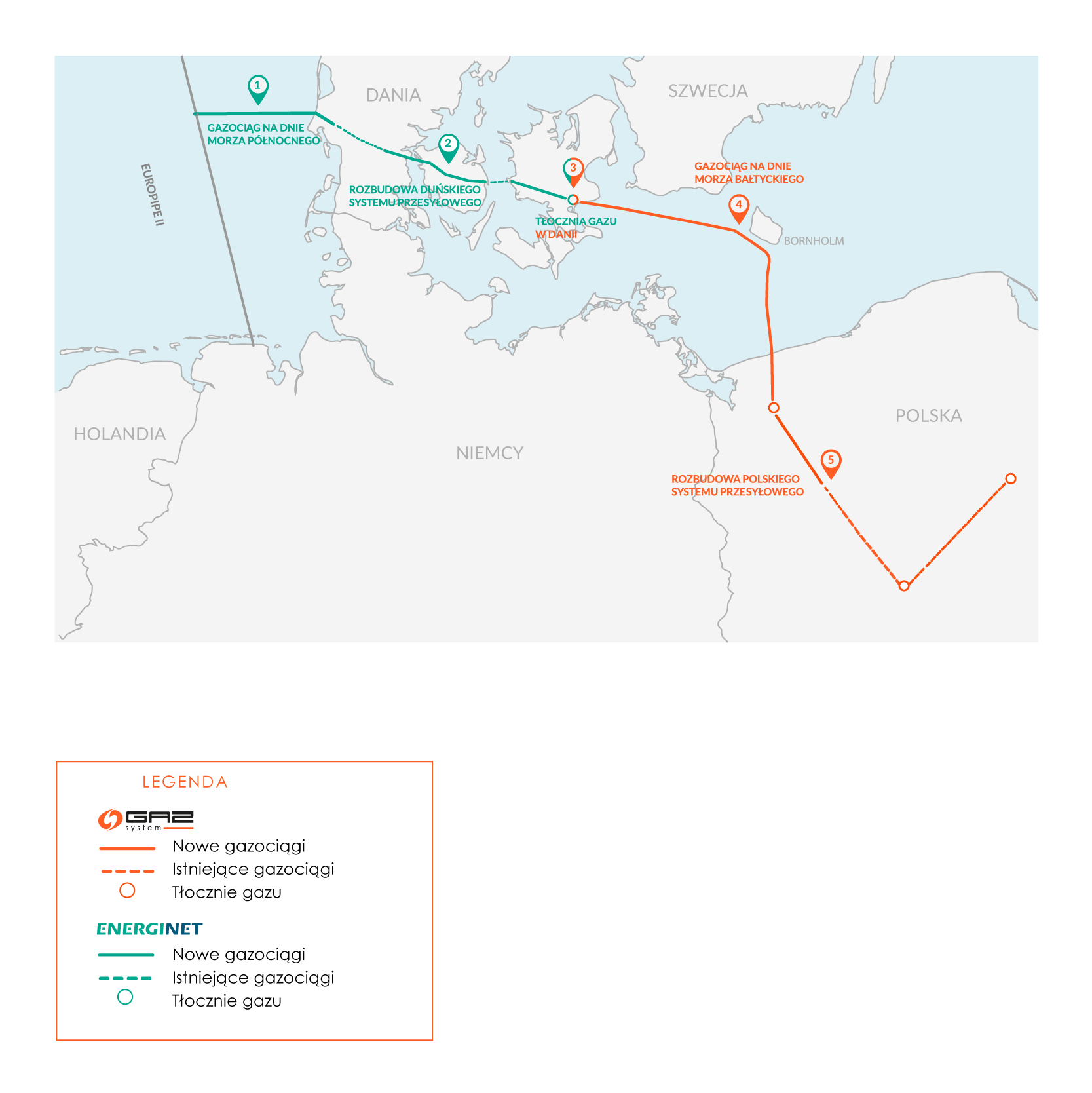Baltic Pipe
The Baltic Pipe project is a strategic infrastructure project aimed at creating a new gas supply corridor in the European market. It made it possible, for the first time ever, to transport gas directly from fields in Norway to markets in Denmark and Poland, as well as to customers in neighboring countries in Central and Eastern Europe. At the same time, the Baltic Pipe project has enabled bi-directional transmission, i.e. gas can be delivered from Poland to Denmark.
- 900 km - the estimated total length of the pipelines
- 4 gas compressor stations
- 10 bcm - capacity of the offshore gas pipeline
The Baltic Pipe project consists of 5 main components:
1) North Sea offshore gas pipeline
A subsea gas pipeline connecting the Norwegian and Danish transmission systems.
2) Expansion of the Danish transmission system
Extension of the existing transmission system in Denmark.
3) Gas compressor station in Denmark
Gas compressor station located in East Zealand.
4) Offshore gas pipeline in the Baltic Sea
A submarine gas pipeline connecting the Danish and Polish transmission systems.
5) Expansion of the Polish gas transmission system
Expansion of the existing transmission system in Poland, including:
- Construction of a gas pipeline connecting the offshore pipeline with the national transmission system.
- Construction of a gas pipeline from Goleniów to Lwówek.
- Expansion of the Goleniów Compressor Station.
- Construction of the Gustorzyn gas compressor station.
- Expansion of the gas compressor station in Odolanów.
Danish gas transmission system operator Energinet was responsible for the implementation of the first three components in Denmark, while GAZ-SYSTEM was responsible for the construction of the offshore gas pipeline between Denmark and Poland and the expansion of the gas transmission system in Poland.
Project status:
On October 1, 2022, gas transportation was launched.
Route and location of the project:
The project runs from the North Sea, where it connected to Europipe II providing access to gas from Norwegian fields. The pipeline was then connected to the Polish transmission system through newly built infrastructure in Denmark and on the Baltic Sea bed.
For more information on the locations, visit the websites of the individual projects included in Baltic Pipe.

The Feasibility Study has been prepared by a consortium consisting of Rambøll Danmark A/S and BSiPG GAZOPROJEKT S.A. together with Ernst & Young as a subcontractor, under the Contract signed on 15 March 2016.
Information about the contractors for individual components of the project can be found in the respective dedicated sections.
The project was implemented on the basis of the provisions of the Act of 24 April 2009 on investments in regasification terminal for liquefied natural gas in Świnoujście (for consolidated text see Journal of Laws of 2021, item 1836).
The project received funding from the European Union under the Connecting Europe Facility (CEF) programme. In January 2019, the Commission granted nearly 215 million Euro to GAZ-SYSTEM as the co-financing of construction works (the agreement on financial support for the project was signed on 15 April 2019).
In 2017 and 2018, the project received support for preparatory works, in the amount of over 33.1 million Euro, and for pre-investment works (18.3 million Euro). This amount includes funds allocated to both GAZ-SYSTEM and ENERGINET (GAZ-SYSTEM received nearly 28.4 million Euro). Following a competition held in 2015, the project also received co-financing, in the amount of nearly 400 thousand Euro, for the feasibility study.
The total amount of EU support granted to date for the Baltic Pipe project amounts to over 266 million Euro, of which GAZ-SYSTEM has been awarded nearly 243.5 million Euro.
The European Commission has granted the PCI (Project of Common Interest) status to the project. More information on the significance of the PCI status for the development of gas transmission infrastructure can be found in the dedicated section on PCI projects.
While implementing its investment projects GAZ-SYSTEM S.A. respects the rights of all interested parties. You are encouraged to send comments and questions concerning any project which was granted the PCI status using the Form for questions and comments concerning the implementation of projects with PCI status by GAZ- SYSTEM.


















